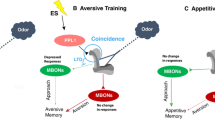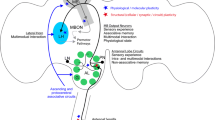Abstract
The pathways for olfactory learning in the fruitfly Drosophila have been extensively investigated, with mounting evidence that that the mushroom body is the site of the olfactory associative memory trace (Heisenberg, Nature 4:266–275, 2003; Gerber et al., Curr Opin Neurobiol 14:737–744, 2004). Heisenberg’s description of the mushroom body as an associative learning device is a testable hypothesis that relates the mushroom body’s function to its neural structure and input and output pathways. Here, we formalise a relatively complete computational model of the network interactions in the neural circuitry of the insect antennal lobe and mushroom body, to investigate their role in olfactory learning, and specifically, how this might support learning of complex (non-elemental; Giurfa, Curr Opin Neuroethol 13:726–735, 2003) discriminations involving compound stimuli. We find that the circuit is able to learn all tested non-elemental paradigms. This does not crucially depend on the number of Kenyon cells but rather on the connection strength of projection neurons to Kenyon cells, such that the Kenyon cells require a certain number of coincident inputs to fire. As a consequence, the encoding in the mushroom body resembles a unique cue or configural representation of compound stimuli (Pearce, Psychol Rev 101:587–607, 1994). Learning of some conditions, particularly negative patterning, is strongly affected by the assumption of normalisation effects occurring at the level of the antennal lobe. Surprisingly, the learning capacity of this circuit, which is a simplification of the actual circuitry in the fly, seems to be greater than the capacity expressed by the fly in shock-odour association experiments (Young et al. 2010).












Similar content being viewed by others
References
Armstrong, D., & van Hemert, J. (2009). Towards a virtual fly brain. Philosophical Transactions of the Royal Society Mathematical, Physical and Engineering Sciences, 367, 2387–2397.
Aso, Y., Gruebel, K., Busch, S., Friedrich, A., Siwanowicz, I., et al. (2009). The mushroom body of adults Drosophila characterized by GAL4 drivers. Journal of Neurogenetics, 23, 156–172.
Assisi, C., Stopfer, M., Laurent, G., & Bazhenov, M. (2007). Adaptive regulation of sparseness by feedforward inhibition. Nature Neuroscience, 10, 1176–1184.
Brembs, B., & Wiener, J. (2006). Context and occasion setting in Drosophila visual learning. Learning and Memory, 13, 618–628.
Busto, G., Cervantes-Sandoval, I., & Davis, R. (2010). Olfactory learning in Drosophila. Physiology, 25, 338–346.
Cassenaer, S., & Laurent, G. (2007). Hebbian STDP in mushroom bodies facilitates the synchronous flow of olfactory information in locusts. Nature, 448, 709–713. doi:10.1038/nature05973.
Chittka, L., & Niven, J. (2009). Are bigger brains better? Current Biology, 19, R995–R1008.
Chou Y. H., Spletter, M., Yaksi, E., Leong, J., Wilson, R., et al. (2010). Diversity and wiring variability of olfactory local interneurons in the Drosophila antennal lobe. Nature Neuroscience, 13, 439–449.
Claridge-Chang, A., Roorda, R., Vrontou, E., Sjulson, L., Li, H., et al. (2009). Writing memories with light-addressable reinforcement circuitry. Cell, 139, 405–415.
Cleland, T., & Linster, C. (1999). Concentration tuning mediated by spare receptor capacity in olfactory sensory neurons: A theoretical study. Neural Computation, 11, 1673–1690.
Couto, A., Alenius, M., & Dickson, B. (2005). Molecular, anatomical, and functional organization of the Drosophila olfactory system. Current Biology, 17, 1535–1547.
Deisig, N., Lachnit, H., Giurfa, M., & Hellstern, F. (2001). Configural olfactory learning in honeybees: Negative and positive patterning discrimination. Learning and Memory, 8, 70–78.
Gerber, B., Tanimoto, H., & Heisenberg, M. (2004). An engram found? Evaluating the evidence from fruit flies. Current Opinion in Neurobiology, 14, 737–744.
Giurfa, M. (2003). Cognitive neuroethology: Dissecting non-elemental learning in a honeybee brain. Current Opinion in Neuroethology, 13, 726–735.
Gutierrez-Osuna, R. (2002). A self-organizing model of chemotopic convergence for olfactory coding. In Proceedings of the second joint EMBS/BMES conference (pp. 236–237). Houston, TX, USA.
Hallem, E., Dahanukar, A., & Carlson, J. (2006). Insect odor and taste receptors. Annual Review of Entomology, 51, 113–135.
Heisenberg, M. (2003). Mushroom body memoir: From maps to models. Nature, 4, 266–275.
Huang, J., Zhang, W., Qiao, W., Hu, A., & Wang, Z. (2010). Functional connectivity and selective odor responses of excitatory local interneurons in Drosophila antennal lobe. Neuron, 67, 1021–1033.
Huerta, R., & Nowotny, T. (2009). Fast and robust learning by reinforcement signals: Explorations in the insect brain. Neural Computation, 21, 2123–2151.
Huerta, R., Nowotny, T., Garcia-Sanchez, M., Abarbanel, H., & Rabinovich, M. (2004). Learning classification in the olfactory system of insects. Neural Computation, 16, 1601–1640.
Ito, I., Bazhenov, M., Ying Ong R.C., Raman, B., & Stopfer, M. (2009). Frequency transitions in odor-evoked neural oscillations. Neuron, 64, 692–706.
Izhikevich, E. (2007a). Dynamical systems in neuroscience: The geometry of excitability and bursting. Cambridge, MIT Press.
Izhikevich, E. (2007b). Solving the distal reward problem through linkage of STDP and dopamine signaling. Cerebral Cortex, 17, 2443–2452.
Jayaraman, V., & Laurent, G. (2009). Olfactory system: Circuit dynamics and neural coding in the locust. In Encyclopedia of neuroscience (pp. 187–196).
Keene, A., & Waddell, S. (2007). Drosophila olfactory memory: Single genes to complex neural circuits. Nature Reviews Neuroscience, 8, 341–354.
Kohonen, T. (1990). The self-organizing map. Proceedings of the IEEE, 78, 1464–1480.
Komischke, B., Sandoz, J. C., Lachnit, H., & Giurfa, M. (2003). Non-elemental processing in olfactory discrimination tasks needs bilateral input in honeybees. Behavioral Brain Research, 145, 135–143.
Krashes, M., Keene, A., Leung, B., Armstrong, D., & Waddell, S. (2007). Sequential use of mushroom body neuron subsets during Drosophila odor memory processing. Neuron, 53, 103—115.
Laissue, P., Reiter, C., Hiesinger, P., Halter, S., Fischbach, K., et al. (1999) Three-dimensional reconstruction of the antennal lobe in Drosophila melanogaster. Journal of Comparative Neurology, 405, 543–552.
Lancet, D., Sadovsky, E., & Seidemann, E. (1993). Probability model for molecular recognition in biological receptor repertoires: Significance to the olfactory system. Proceedings of the National Academy of Sciences (PNAS), 90, 3715–3719.
Liang, L., & Luo, L. (2010). The olfactory circuit of the fruit fly Drosophila melanogaster. Science China Life Sciences, 53, 472–484.
Linster, C., Sachse, S., & Galizia, G. (2005). Computational modeling suggests that response properties rather than spatial position determine connectivity between olfactory glomeruli. Journal of Neurophysiology, 93, 3410–3417.
Martinez, D., & Montejo, N. (2008). A model of stimulus-specific neural assemblies in the insect antennal lobe. PLoS Computational Biology, 4, e1000139.
Masuda-Nakagawa, L., Tanaka, N., & O’Kane, C. (2005). Stereotypic and random patterns of connectivity in the larval mushroom body calyx of Drosophila. Proceedings of the National Academy of Sciences (PNAS), 102, 19027–19032.
Matsumoto, Y., & Mizunami, M. (2004). Context-dependent olfactory learning in an insect. Learning and Memory, 11, 288–293.
Mizunami, M., Unoki, S., Mori, Y., Hirashima, D., Hatano, A., et al. (2009). Roles of octopaminergic and dopaminergic neurons in appetitive and aversive memory recall in an insect. BMC Biology, 7, 46.
Murthy, M., Fiete, I., & Laurent, G. (2008). Testing odor response stereotypy in the Drosophila mushroom body. Neuron, 59, 1009–1023.
Nowotny, T., Huerta, R., Abarbanel, H., & Rabinovich, M. (2005). Self-organization in the olfactory system: One shot odor recognition in insects. Biological Cybernetics, 93, 436–446.
Olsen, S., Bhandawat, V., & Wilson, R. (2010). Divisive normalization in olfactory population codes. Neuron, 66, 287–299.
Pearce, J. (1994). Similarity and discrimination: A selective review and a connectionist model. Psychological Review, 101, 587–607.
Rescorla, R. (1973). Evidence for “unique stimulus” account of configural conditioning. Journal of Comparative and Physiological Psychology, 85, 331–338.
Sato, C., Matsumoto, Y., Sakura, M., & Mizunami, M. (2006). Contextual olfactory learning in cockroaches. NeuroReport, 17, 553–557.
Schubert, M., Lachnit, H., Francucci, S., & Giurfa, M. (2002). Non-elemental visual learning in honeybees. Animal Behaviour, 64, 175–184.
Schwaerzel, M., Heisenberg, M., & Zars, T. (2002). Extinction antagonizes olfactory memory at the subcellular level. Neuron, 35, 951–960.
Seki, Y., Rybak, J., Wicher, D., Sachse, S., & Hansson, B. (2010). Physiological and morphological characterization of local interneurons in the Drosophila antennal lobe. Journal of Neurophysiology, 104, 1007–1019.
Silbering, A., & Galizia, G. (2007). Processing of odor mixtures in the Drosophila antennal lobe reveals both global inhibition and glomerulus-specific interactions. Journal of Neuroscience, 27, 11966–11977.
Smith, D., Wessnitzer, J., & Webb, B. (2008). A model of associative learning in the mushroom body. Biological Cybernetics, 99, 89–103.
Song, S., Miller, K., & Abbott, L. (2000). Competitive Hebbian learning through spike-timing-dependent synaptic plasticity. Nature Neuroscience, 3, 919–926.
Tanaka, N., Tanimoto, H., & Ito, K. (2008). Neuronal assemblies of the Drosophila mushroom body. Journal of Comparative Neurology, 508, 711–755.
Thum, A., Jenett, A., Ito, K., Heisenberg, M., & Tanimoto, H. (2007). Multiple memory traces for olfactory reward learning in Drosophila. Journal of Neuroscience, 27, 11132–11138.
Tomchik, S., & Davis, R. (2009). Dynamics of learning-related camp signaling and stimulus integration in the Drosophila olfactory pathway. Neuron, 64, 510–521.
Turner, G., Bazhenov, M., & Laurent, G. (2008). Olfactory representations by Drosophila mushroom body neurons. Journal of Neurophysiology, 99, 734–746.
Waddell, S. (2010). Dopamine reveals neural circuit mechanisms of fly memory. Trends in Neurosciences, 33, 457–464.
Wang, J., Wong, A., Flores, J., Vosshall, L., & Axel, R. (2003). Two-photon calcium imaging reveals an odor-evoked map of activity in the fly brain. Cell, 112, 271–282.
Wessnitzer, J., Webb, B., & Smith, D. (2007). A model of non-elemental associative learning in the Mushroom Body neuropil of the insect brain. In Proceedings of the international conference on adaptive and natural computing algorithms ICANNGA’07 (pp. 488–497). Warsaw, Poland.
Wilson, R., Turner, G., & Laurent, G. (2004). Transformation of olfactory representations in the Drosophila antennal lobe. Science, 303, 366–370.
Wuestenberg, D., Boytcheva, M., Gruenewald, B., Byrne, J., Menzel, R., et al. (2004) Current- and voltage-clamp recordings and computer simulations of Kenyon cells in the honeybee. Journal of Neurophysiology, 92, 2589–2603.
Yamagata, N., Schmuker, M., Szyszka, P., Mizunami, M., & Menzel, R. (2009). Differential odor processing in two olfactory pathways in the honeybee. Frontiers in Systems Neuroscience, 3, Article 16, 1–13.
Yarali, A., Hendel, T., & Gerber, B. (2006). Olfactory learning and behaviour are ‘insulated’ against visual processing in larval Drosophila. Journal of Comparative Physiology A, 192, 1133–1145.
Yarali, A., Mayerle, M., Nawroth, C., & Gerber, B. (2008). No evidence for visual context-dependency of olfactory learning in Drosophila. Naturwissenschaften, 95, 767–774.
Young, J., Wessnitzer, J., Armstrong, J., & Webb, B. (2010). Can flies learn complex olfactory associations? In International congress on neuroethology abstract. Salamanca, Spain.
Yu, D., Ponomarev, A., & Davis, R. (2004). Altered representation of the spatial code for odors after olfactory classical conditioning: Memory trace formation by synaptic recruitment. Neuron, 42, 437–449.
Acknowledgement
This work was supported by EPSRC grant EP/F030673/1.
Author information
Authors and Affiliations
Corresponding author
Additional information
Action Editor: C. Linster
Electronic Supplementary Material
Below is the link to the electronic supplementary material.
Rights and permissions
About this article
Cite this article
Wessnitzer, J., Young, J.M., Armstrong, J.D. et al. A model of non-elemental olfactory learning in Drosophila . J Comput Neurosci 32, 197–212 (2012). https://doi.org/10.1007/s10827-011-0348-6
Received:
Revised:
Accepted:
Published:
Issue Date:
DOI: https://doi.org/10.1007/s10827-011-0348-6




